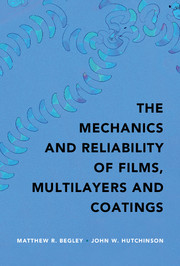Book contents
- Frontmatter
- Contents
- Acknowledgements
- Notation
- 1 Introduction
- 2 Key Mechanics Concepts
- 3 Linear Elastic Fracture Mechanics
- 4 Steady-State Delamination of Bilayers
- 5 Steady-State Delamination in Multilayers
- 6 Steady-State Channeling and Tunneling Cracks
- 7 Crack Kinking from an Interface
- 8 Crack Penetration, Deflection or Arrest?
- 9 Edge and Corner Interface Cracks
- 10 Buckling Delamination
- 11 Delamination of Thin Strips (Patterned Lines)
- 12 Delamination in Multilayers Subject to Steady-State Temperatures
- 13 Cracking under Transient Temperature Distributions
- 14 Software for Semi-Infinite Multilayers: Steady-State Delamination
- 15 Software for Semi-Infinite Multilayers: Transient Delamination
- 16 Finite Element Software for Multilayers: LayerSlayer FEA
- 17 Convergence and Benchmarks with LayerSlayer FEA
- Appendix Asymptotic Crack Tip Displacement Fields for an Interface Crack
- References
- Index
14 - Software for Semi-Infinite Multilayers: Steady-State Delamination
Published online by Cambridge University Press: 13 July 2017
- Frontmatter
- Contents
- Acknowledgements
- Notation
- 1 Introduction
- 2 Key Mechanics Concepts
- 3 Linear Elastic Fracture Mechanics
- 4 Steady-State Delamination of Bilayers
- 5 Steady-State Delamination in Multilayers
- 6 Steady-State Channeling and Tunneling Cracks
- 7 Crack Kinking from an Interface
- 8 Crack Penetration, Deflection or Arrest?
- 9 Edge and Corner Interface Cracks
- 10 Buckling Delamination
- 11 Delamination of Thin Strips (Patterned Lines)
- 12 Delamination in Multilayers Subject to Steady-State Temperatures
- 13 Cracking under Transient Temperature Distributions
- 14 Software for Semi-Infinite Multilayers: Steady-State Delamination
- 15 Software for Semi-Infinite Multilayers: Transient Delamination
- 16 Finite Element Software for Multilayers: LayerSlayer FEA
- 17 Convergence and Benchmarks with LayerSlayer FEA
- Appendix Asymptotic Crack Tip Displacement Fields for an Interface Crack
- References
- Index
Summary
In this chapter, we describe software that analyzes multilayers that are at steady-state conditions with respect to time; in order to be applicable, the multilayers’ width must be much larger than the total stack thickness, such that one can neglect lateral gradients in the direction of the layers. The software can be used to determine the temperature distribution in the layers, the deformation (elongation and stretch) and stress distribution in the layers of the multilayer, or any submultilayers formed by delamination cracks. The software is based on one-dimensional heat transfer described in Section 2.6 and general multilayer mechanics framework outlined in Chapter 5. The software is applicable to any number of layers, and using this framework, the results can be used to compute the energy release rates for semi-infinite delamination cracks located at any location in the stack. The code associated with this chapter has been dubbed LayerSlayer (LS).
Since the energy release rate associated with a semi-infinite crack in a semi-infinite multilayer is independent of the crack length, the results are also at steady state with respect to crack length, which almost always represents the maximum possible value for any crack length. Hence, in this chapter, steady state refers to both time and crack length. One should recall that the analysis in Chapter 5 does not yield the mode mix, which requires full solution of the associated elasticity problem. This is covered in Chapter 16.
A complementary code that solves for time-dependent (transient) behavior under the same geometric restrictions as imposed in this chapter is described in the next chapter and is called LayerSlayer Transient (LST). It may be appreciated that the mechanical analysis conducted in LayerSlayer Transient is essentially identical to that in LayerSlayer, only with each physical layer broken into through-thickness elements that describe nonlinear temperature distributions as a series of piecewise linear segments. As such, the interfaces for both LS and LST are remarkably similar. While both are completely self-contained (i.e., the reader can use either code without needing the other), the description of LST builds off this chapter, and hence it is recommended that the reader become familiar with LS first, even if transient solutions are sought.
- Type
- Chapter
- Information
- The Mechanics and Reliability of Films, Multilayers and Coatings , pp. 188 - 207Publisher: Cambridge University PressPrint publication year: 2017



